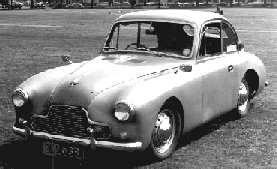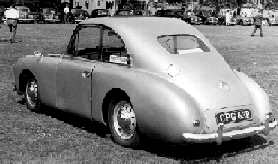site map
Jowett Jupiter sports cars owned by famous people
who are famous for other reasons than Jowett Jupiter ownership
Red Skelton
|
The death in 1997 of USA Radio and TV entertainer Red Skelton
(right) was a reminder that
some famous people who were at one time or another Jupiter owners.
Even though only 900 Jupiters were built, more than a handful were owned by men
known to a wider circle than just their family and work colleagues. All these men are
famous for reasons other than having been Jupiter owners.
The three most famous ex-owners must be John Surtees, Peter
Ustinov, and Red Skelton
plus friends. There are several others including Peter Craven the
speedway ace, John Willment (who with John Wyer was one of the two JW's
of JW Automotive) and Don Cockell the Light-heavyweight boxing champion -
see below. |
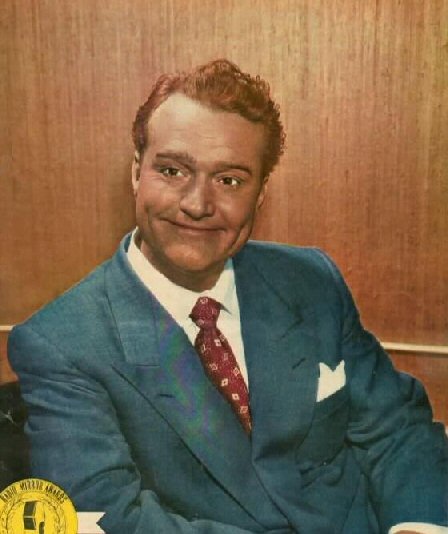 |
John Surtees
It was Mike Hawthorne who talked motor-cyclist
John Surtees in to switching to car racing
with the unanswerable argument "Why don't you try cars? They stand up easier!".
It is not just
that he is the only person to have been world champion on two wheels as well as four
- the seven motorcycle world championships of John Surtees occurred at a time when motorcycling was far more
popular - and our heroes who raced them were so much better known - than today. In
nineteen-fifties
Britain there were one million motorcyclists and only four million cars. Most of the latter
were driven by ex two-wheelers. Bob Foster (who rallied a Javelin), Geoff Duke,
John Surtees, Mike Hailwood,
Phil Read, Barry Sheene - they were household
names for us all, much more so than the racing car drivers. And the camaraderie! If you
broke down (as sometimes happened - they were British bikes we rode after all) the
next bike would always stop. Read on to find out about another famous
motorcyclist who owned a Jupiter around the same time.
Born into a motorcycling background - his father was an amateur racer -
Surtees
began racing on two wheels in 1951. From 1956-1960 John Surtees was the outstanding
rider of the day, taking his seven World Championship titles on 350cc and 500cc
machines. In 1960 he raced a Ken Tyrrell Cooper car at Goodwood - and won. John
made his Grand Prix debut in 1960 for Team Lotus, and in 1964 he won the Formula
1 World Championship driving for Ferrari. In total John Surtees drove in 111 Grands
Prix, scoring a total of six wins, eight pole positions and eleven fastest laps.
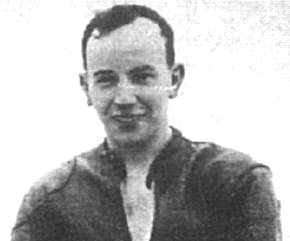 |
John Surtees in motor-cycle
leathers, taken around the time he was a Jupiter owner.
He remembered the car with great
affection.
A saloon-bodied Jupiter entered his collection for a while - see
below. |
The first car
of John Surtees (after taking his driving test in his mother's Morris Minor which ran out of
petrol during the test) came about as follows "When I was
travelling backwards and forwards to Stevenage [serving his apprenticeship at Vincent-HRD] one
particularly foul day I stopped at a garage in Hatfield and saw
this lovely gold Jupiter in a showroom and couldn’t resist it. My
father arranged the Hire Purchase deal. It was a super little car...I
didn’t modify the Jupiter in anyway because I was too busy, working a full day
at Stevenage and having to get home to prepare my bikes in the evenings. But it
gave me excellent service, and was under-rated by many people. My memories are
of superb performance and roadholding, which gave me trouble-free running".
He replaced it with a Porsche 356 which John recalled, was the first car that he
'lost' on a bend.
 John Surtees - his first four-wheeler was a
bronze standard Jupiter. In his 1963 book Speed - The John Surtees Story, he writes of
his time as an apprentice at HRD. During that time he rode several 2-wheelers including his
mother's BSA Bantam! A spell of bad weather persuaded him to look for something more
comfortable, and out of the prize money he was then earning he bought his first car:
"Quite a nice semi-sports on which I'd had my eye for some time"
as he described his Jupiter.
He used it to carry motorcycle parts, and to visit London's theatre-land for such shows as
Can Can - in time the Jupiter was inevitably replaced by a Porsche 356. The Jupiter's chassis
and a few other bits survive.
John Surtees - his first four-wheeler was a
bronze standard Jupiter. In his 1963 book Speed - The John Surtees Story, he writes of
his time as an apprentice at HRD. During that time he rode several 2-wheelers including his
mother's BSA Bantam! A spell of bad weather persuaded him to look for something more
comfortable, and out of the prize money he was then earning he bought his first car:
"Quite a nice semi-sports on which I'd had my eye for some time"
as he described his Jupiter.
He used it to carry motorcycle parts, and to visit London's theatre-land for such shows as
Can Can - in time the Jupiter was inevitably replaced by a Porsche 356. The Jupiter's chassis
and a few other bits survive.
For our younger readers, John Surtees is the only man to
have been world champion on two wheels and four. Born in Tatsfield, Surrey,
Surtees won seven world titles in motorcycle racing, winning the 350cc
championship from 1958 to 1960, and the 500cc title four times, in 1956 and
1958, 1959 and 1960. Surtees then switched to cars full time in 1960 making
his Formula 1 debut with Lotus in the Monaco GP that year. He then moved to
Ferrari and won the world F1 title for them in 1964.
In 1990 John Surtees added a special bodied Jupiter
(by Coachcraft of Egham)
to his collection of two and four-wheelers, and here are scanned in a
couple of pictures of this handsome vehicle for your delight. They were
taken during the nineteen-sixties but it looks much the same today
although it has had its original registration mark restored to it. Alas
John has other fish to fry and he did not get it running again.
Eventually it was sold to a French collector who had a total rebuild
carried out on it by a British Classic car specialist
 Peter Ustinov
owned a special-bodied Jupiter in the ninteen-fifties, and it accompanied him to California for a
couple of years. This Jupiter is in good order although stored for a while - its current owner is
famed Jupiter-man Dennis Sparrow. (Dennis also owns a standard Jupiter, a 1938
Jowett van, and co-owns the surviving R1 Le Mans Jupiter (class 1 winner Le
Mans 1952) and a Jowett
vintage car of 1927 manufacture.
Peter Ustinov
owned a special-bodied Jupiter in the ninteen-fifties, and it accompanied him to California for a
couple of years. This Jupiter is in good order although stored for a while - its current owner is
famed Jupiter-man Dennis Sparrow. (Dennis also owns a standard Jupiter, a 1938
Jowett van, and co-owns the surviving R1 Le Mans Jupiter (class 1 winner Le
Mans 1952) and a Jowett
vintage car of 1927 manufacture.
 Red Skelton
known as the Clown Forever came to
England in 1951 and bought no less than four Jupiters - all RHD bought directly from the Jowett factory. They were for
himself, Gene
Fowler, David Rose, and Bo Christian Roos. They probably didn't use them
much! British-born composer
David Rose came to Hollywood in the early war years, contributing scores
to such films as Winged
Victory
(1944) and Jupiters Darling (1954), one of several MGMs musicals for
which he composed the music, but this film is not about motor cars.
He worked extensively as an
orchestra leader on radio, and in this capacity began a long and lucrative
association with Red Skelton with whom Rose stayed until Skelton's final
TV program in 1971. Skelton's theme song, Holiday For Strings, was
written by David Rose, as were the leitmotifs of Skelton's many characters (The David Rose
clip-clop theme for Freddy the Freeloader was titled Lovable Clown).
Another sterling contribution to television history was The david Rose evocative
theme music for Bonanza. David Rose
may also be remembered for being the first of the five husbands of Judy
Garland. Red Skelton used his Jupiter for about four years. The
Skelton and Fowler Jupiters survive in California and restoration of both is completed.
Red Skelton
known as the Clown Forever came to
England in 1951 and bought no less than four Jupiters - all RHD bought directly from the Jowett factory. They were for
himself, Gene
Fowler, David Rose, and Bo Christian Roos. They probably didn't use them
much! British-born composer
David Rose came to Hollywood in the early war years, contributing scores
to such films as Winged
Victory
(1944) and Jupiters Darling (1954), one of several MGMs musicals for
which he composed the music, but this film is not about motor cars.
He worked extensively as an
orchestra leader on radio, and in this capacity began a long and lucrative
association with Red Skelton with whom Rose stayed until Skelton's final
TV program in 1971. Skelton's theme song, Holiday For Strings, was
written by David Rose, as were the leitmotifs of Skelton's many characters (The David Rose
clip-clop theme for Freddy the Freeloader was titled Lovable Clown).
Another sterling contribution to television history was The david Rose evocative
theme music for Bonanza. David Rose
may also be remembered for being the first of the five husbands of Judy
Garland. Red Skelton used his Jupiter for about four years. The
Skelton and Fowler Jupiters survive in California and restoration of both is completed.
|
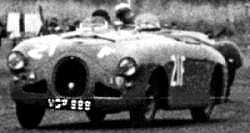
|
|
 |
|
Gerald Lascelles driving his Radford bodied Jupiter
in the 1952 Relay Race at Silverstone |
|
Dennis Sparrow's ex Peter Ustinov special-bodied Jupiter at a
Jowett Car Club rally back in the nineteen-seventies |
Other Jupiter-owning notables include W Tee, proprietor of the respected
British magazine
Motor
Sport, who owned first a Mk1 and later a Mk1a. These cars were occasionally
mentioned in the magazine by the editor Bill Boddy, a regular and appreciative driver of
the Jupiters, in the early fifties. The Scottish accordionist-band-leader,
Sir Jimmy Shand, a household name in the 1950s and 1960s (who
died 23 December 2000 aged 92) owned a Jupiter (which still exists) in the mid-to-late
fifties during the height of his fame, and the late Queen's cousin Gerald Lascelles owned,
raced, and honeymooned in a special-bodied Jupiter which also still exists and
which is under restoration as you read this. Lascelles, besides having
been the grandson of King George V on his mother's side and therefore close to England, also wrote for the
English magazine Jazz Journal, and was from 1964 to 1971 the president of the BRDC
(British Racing Drivers' Club); as such he oversaw the expansion of Silverstone from just
one of several British circuits to become the leading track and home of the British Grand
Prix. Finally the explorer-cum exploration travel-agent and author Colonel
John Blashford-Snell
owned a standard green Jupiter he called the Green Goddess - see his book "Where
the Trowell Ends". All these Jupiters even the Green Goddess survive.
Remember JW Automotive? It was formed by John Willment and John Wyer to take
over the premises and activities of Ford Advanced Vehicles, Slough, England in
1967, where they also produced the last Shelby Cobra (the Lone Star). John Wyer had
been the competitions manager at Aston Martin for many years, while John Willment
ran a racing car development shop called Willment Racing, being heavily involved with
preparing Brabhams in the mid 60s, as well as GT40s. The two JWs combined and gave the
GT40 Mk IV another two outright wins at Le Mans, in 1968 and 1969, before switching to the
Gulf Porsche. John Willment was the first owner-driver of Edmund Nankivell's
saloon-bodied Jupiter, built in the Italian style, see below:
| The Willment Jupiter is seen here in Bradford in the
mid-nineteen-nineties.
How much use did John Willment have of this Jupiter in three years? Enough to break its
crank - say 15,000 to 25,000 miles. But it was never raced.
The name Jowett is still often found in Yorkshire today: This shop was selling
hardware,
paraffin, and fancy goods as well as being a heating specialist.
|
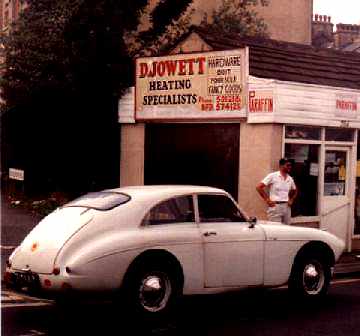 |
The very first owner of the Willment Jupiter, but not its first driver, was
Philip Fotheringham-Parker. It was built for him to drive it in the 1953 Monte
Carlo Rally, but it was not finished in time. Phillip was a well-known motor-sportsman of
the nineteen-thirties, forties, and fifties. He once drove a works Alvis Silver Eagle over the banking at
Brooklands, and survived!
 Boxer Don
Cockell owned a Jupiter in 1952, although which one, and for how long, is
not known to us. A blacksmith by trade, Don Cockell
began boxing in 1946. He was invincible in the Light-heavyweight category and
became the British and Commonwealth champion at that weight. he then began challenging
heavyweights being successful in Europe but not in the US where his brave 1955
fight against Rocky Marciano was stopped in the 9th. He had 81 fights in his career, winning 66 of them
Boxer Don
Cockell owned a Jupiter in 1952, although which one, and for how long, is
not known to us. A blacksmith by trade, Don Cockell
began boxing in 1946. He was invincible in the Light-heavyweight category and
became the British and Commonwealth champion at that weight. he then began challenging
heavyweights being successful in Europe but not in the US where his brave 1955
fight against Rocky Marciano was stopped in the 9th. He had 81 fights in his career, winning 66 of them
 General
Sir Mike Jackson GCB CBE DSO ADC
owned Jupiter OPX 495 when he was stationed in Northern Ireland in the early
1970s, having bought it on 29/8/1969 when he was aged aged 24. In Kosovo he apparently earned the
nickname Macho Jacko and is credited with disobeying an order from Supreme
NATO Commander Gen Wesley Clark, saying I wont start World War III for you ! -
but that is another
story. He rose to be the very top man in the British Army before retiring in
August 2006. Our man crashed his Jupiter in 1973 and it was an insurance
write-off, but it was rescued from the TT Garage, Farnham, to pass through
the hands of several restorers. These days it is a very smart running
Jupiter in its peacock blue livery.
General
Sir Mike Jackson GCB CBE DSO ADC
owned Jupiter OPX 495 when he was stationed in Northern Ireland in the early
1970s, having bought it on 29/8/1969 when he was aged aged 24. In Kosovo he apparently earned the
nickname Macho Jacko and is credited with disobeying an order from Supreme
NATO Commander Gen Wesley Clark, saying I wont start World War III for you ! -
but that is another
story. He rose to be the very top man in the British Army before retiring in
August 2006. Our man crashed his Jupiter in 1973 and it was an insurance
write-off, but it was rescued from the TT Garage, Farnham, to pass through
the hands of several restorers. These days it is a very smart running
Jupiter in its peacock blue livery.
 Colin
Chapman - he of Lotus cars fame - is reliably reported to have owned a
Jupiter in his bachelor days, so would have been during the early 1950s. A
woman said that when she was young, she was asked by the mother of her best
friend to chaperone her best friend by sitting between the said friend and Colin
Chapman in Colin's Jupiter. Anyone
know more?
Colin
Chapman - he of Lotus cars fame - is reliably reported to have owned a
Jupiter in his bachelor days, so would have been during the early 1950s. A
woman said that when she was young, she was asked by the mother of her best
friend to chaperone her best friend by sitting between the said friend and Colin
Chapman in Colin's Jupiter. Anyone
know more?
 Motor-cycling Speedway-man Peter Craven owned a Jupiter in the mid nineteen fifties. It still exists in good order. a very tidy running car. A bit of a
show-off some said; he used to drive the Jupiter to meetings with his motor-bike
attached to the back of the Jupiter! He rode for the Manchester club Belle Vue:
twice world
speedway champion (1955 and 1962) and as a natural-born speedway ace,
Peter Craven,
after three brilliant wins at Meadowbank in 1963, crashed heavily in the fourth
race trying to avoid a fallen rider and
was tragically killed at the height of his powers. Peter Craven is still
remembered by speedway fans. An example from 'A4lawnlady' recalling Peter's
first ride as little lad at Belle Vue Stadium.
"I
can remember him holding on to the bike for grim death. He was so tiny his
feet didn't reach the ground and it was feat of balance. My Dad always
claimed that Peter told him he rode around until he ran out of fuel, because he
had not worked out how to stop the bike without falling off."
Motor-cycling Speedway-man Peter Craven owned a Jupiter in the mid nineteen fifties. It still exists in good order. a very tidy running car. A bit of a
show-off some said; he used to drive the Jupiter to meetings with his motor-bike
attached to the back of the Jupiter! He rode for the Manchester club Belle Vue:
twice world
speedway champion (1955 and 1962) and as a natural-born speedway ace,
Peter Craven,
after three brilliant wins at Meadowbank in 1963, crashed heavily in the fourth
race trying to avoid a fallen rider and
was tragically killed at the height of his powers. Peter Craven is still
remembered by speedway fans. An example from 'A4lawnlady' recalling Peter's
first ride as little lad at Belle Vue Stadium.
"I
can remember him holding on to the bike for grim death. He was so tiny his
feet didn't reach the ground and it was feat of balance. My Dad always
claimed that Peter told him he rode around until he ran out of fuel, because he
had not worked out how to stop the bike without falling off."
The Craven Shield is a
Speedway Cup competition governed by the Speedway Control Board and British
Speedway Promoters’ Association. Founded in 1997, it is of course named in
memory of Peter Craven.
|
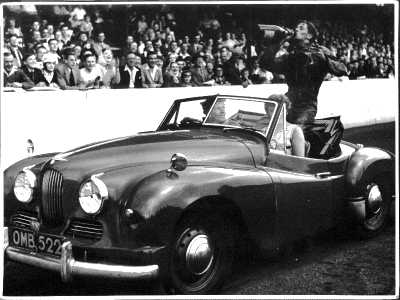 |
|
Above: Peter Craven at Belle Vue driving his Jupiter, with
fiancee and Ron Johnson, also of Belle Vue |
| Below:
Peter Craven (on the right, in blazer) with his brother Brian |
|
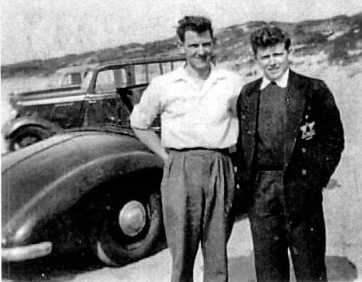 |
Speedway teams in the UK at least as of 2022 were still competing for the Craven Shield,
named after our man Peter Craven of course.
The rules are complicated. The teams finishing 1st to 4th in the
League
Championship are seeded directly to the Semi-Finals, with the remaining
teams being divided into two groups of three. Each team races every every
other team in their group once at home and once away, making a total of four
matches. Points are awarded in the same manner as for the
League
Championship, with total accumulated points determining the final group
placings. The top team in each group qualifies for the Semi-Finals.
The Semi-Finals are held as three-team tournaments, with each team staging a
leg on their own track and aggregate scores deciding the final placings. The
winner of each group plus the best runner-up progresses to the Final which
is staged in the same fashion. Where teams are tied on aggregate for first
place, each team nominates a rider for a runoff.
 Ernest
Dudley pen-name of Vivian Ernest Coltman-Allen
the prolific writer of detective novels, once well-known as the
'Armchair detective'. He was an occasional film maker and briefly an
associate of Fred Astaire. He was the first owner of a special bodied
Jupiter. Although born in 1908, Ernest Dudley was still active almost
to his death in 2006 appearing at book fairs and the like; his books
are being reprinted by the
Wildside Press. A photo of the
ex-Ernest Dudley car, which is still around and often appears at meetings, see below:
Ernest
Dudley pen-name of Vivian Ernest Coltman-Allen
the prolific writer of detective novels, once well-known as the
'Armchair detective'. He was an occasional film maker and briefly an
associate of Fred Astaire. He was the first owner of a special bodied
Jupiter. Although born in 1908, Ernest Dudley was still active almost
to his death in 2006 appearing at book fairs and the like; his books
are being reprinted by the
Wildside Press. A photo of the
ex-Ernest Dudley car, which is still around and often appears at meetings, see below:
|
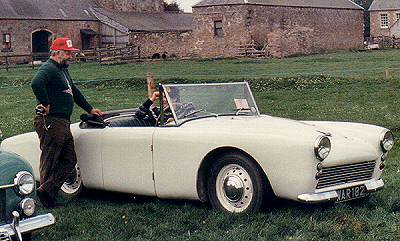 |
|
The ex-Ernest Dudley Jupiter, with body built by Harold
Radford (Coachbuilders) Ltd, seen here with Bill Lock, at the
Melrose Jowett Car Club meeting in 1990. |
Budge Rogers OBE - Bedford and England Rugby Football player
(world record holder of 34 England Rugby Caps), owned and drove his
Jupiter HKY 770 from 1960 to 1964. Born 20 June 1939 in Bedford, his club Bedford recovered after the Second
World War and continued to play all the leading clubs and had a great spell in
the mid ninteen-sixties. There were three Bedford players regularly in the England team
with David Perry and Budge Rogers captaining their county. In 1969-70
season Bedford won the Sunday Telegraph English-Welsh Rugby Table. Probably, the
Blues finest hour was in 1975 when Bedford, captained by Budge Rogers
beat Rosslyn Park in the final of the Knock Out Cup (now Tetley Bitter Cup) at
Twickenham 28-12. There was a gate of nearly 18,000 which at the time was a
record attendance.

Budge Rogers later played for the Barbarians. He managed the England
under 23s to Canada in 1977. The
Ugby Football Union (RFU) organised an England tour to the Far East and England,
led by Budge Rogers,
played two tests in Japan and two tests in Colombo. In the mid 1980s he was
chairman of the England selectors. In 2000 he was managing the England
team.
In 2001 he was the RFU President and then on the board of Trustees
of the Lord's Taverners. D P (Budge) Rogers, OBE is the holder of the
England record of 34 caps,
British Lion and Barbarian many times over, captain
of England on several occasions and the first English player to be honoured by
the Queen for his services to football.
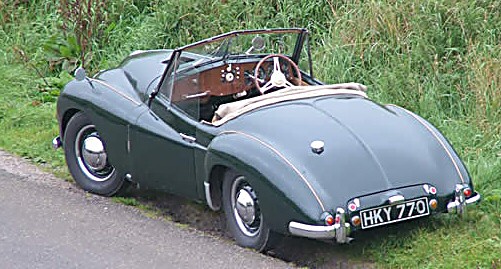
The ex-Budge Rogers Jupiter HKY 770 has been
thoroughly and sensitively restored, as the above photo attests !
Joe Kelly has some considerable fame as a more than competent Irish Grand Prix racing-car driver.
Joe Kelly also was the secondowner of a Jupiter which still exists restored and running.
He
is known to have raced this Jupiter at Goodwood, Boreham, and Isle of
Man plus events in Ireland:- a race at Curragh and hillclimb at Wicklow
Here below he is racing his Alta in the 1950 British Grand Prix at
Silverstone (the very first World Championship F1 race); he is following Geoffrey Crossley also in an Alta.

...and here below is Joe Kelly racing his Jupiter at Boreham in June 1952 - photo
taken by Guy Griffiths:
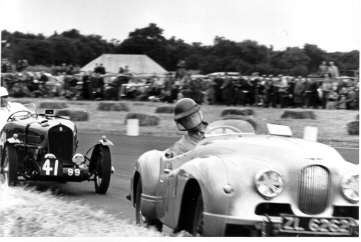
Peter Owen-Smith writes from South Africa:
"I was reading your section on famous
Jupiter owners. South African cricket captain of the 1960s era,
Peter
van der Merwe, owned a red Jupiter when he was still playing in Groot
Drakenstein (near Stellenbosch in the Cape).
This was long before he even
played provincial cricket, never mind internationals. I thought you might be
interested".
Robbie Mackenzie-Low, sometime racing driver, owned and competed in a
Jupiter four times, before moving on to Cooper and then Elva. It is HKW 429, and Robbie raced twice at Goodwood and drove it in
two club rallies. The Robbie Mackenzie-Low
Jupiter still
exists. It - from 2018 - fully restored and running in Yorkshire.
It was
Sir William Lithgow
who was the first owner of a Jupiter - from 1952 to 1955. He had it
registered HS1 becaise he had owned an Hispano-Suiza registered HS1.
William Lithgow was a shipbuilder by trade, an engineer and
technologist by inclination. He was chairman of Lithgows, which was
once the largest privately owned shipbuilding business in the world.
Merged in 1969 to form Scott Lithgow, the firm was nationalised in the
late 1970s, and Sir William retreated to the family estate at Ormsary,
in Argyll.
Sir WJ Lithgow’s
address in the Factory Records,
Gleddoch House at Langbank,
is now a 75-bed 4-star hotel set in the original 360 acres. His father, the more
famous Sir James Lithgow, died 6 months before the Jupiter arrived, allowing the
son to take up his father's knighthood as well as inheriting the chairmanship of
the family firm.
The Jupiter is a well-restored running car now JHS 365
Here
is a true tale very likeable about Sir James Lithgow:
George MacLeod was a World War I decorated hero
whose experience had turned him against war. In Spring 1938, he was struggling
to establish the Iona Community as a venture of Christian outreach in Scotland.
He had no money. He tells the story best:-
I wrote to the richest man I knew. He
replied, recommending a good psychiatrist. Then I wrote to the second
richest man I knew, but he hasn't replied yet; and as that was fifty
years ago I don't suppose he will now. Then I wrote to Sir James Lithgow
[a shipbuilding magnate]. He invited me to his home. That surprised me
because we were not very close: he was building battleships and I was
already a pacifist. Before I left, he asked, 'If I give you 5000 pounds,
will you give up your pacifism?' 'Not on your life,' I replied. Then he
said, 'Then I will give you 5000 pounds.'
In 1943, with World War II raging, anonymous
donors (later revealed as Sir James and Lady Lithgow), committed 20,000 GB pounds Sterling a
year for seven years to the Iona Community.
Philip Marlowe
The fictional detective
Philip Marlowe in the Raymond
Chandler book The Long Goodbye commented:-
We went to Victors. He drove me in a rust
colored Jupiter-Jowett
with a flimsy canvas rain top under which there was only just room for
the two of us. It
had pale leather upholstery and what looked like silver fittings. I'm
not too fussy about
cars, but the damn thing did make my mouth water a little. He said it
would do sixty-five
in second. It had a squatty little gear shift that barely came up to
his knees.
Thanks to Bruce H. Smith for sending this to me.
It could be that Raymond Chandler had read of the
Jupiter R4 and was trying to explain
to Jowett what WOULD sell un the US market...
In late October 2000 Paul Fessenden sent this message about
Ross Thomas:-
"I
read a book that mentioned a Jowett-Jupiter and searched the web to satisfy my
curiosity. The book
was a novel called "Voodoo, Ltd." by
Ross Thomas (quite likely). Paul wrote that he had searched through
a half dozen books on airplanes so may have the wrong book but he is about 90%
certain.
It was a quick mention. Someone was waiting for an appointment to
arrive and was musing that they would probably show up in a stretch limo, a Mercedes
500, or maybe a Jowett-Jupiter. This was to give the impression that this person
for whom they were waiting was wealthy and showy".
||Jupiter (cars!) photos||Jupiter Specification||Buy the
Jupiter
Book||Buy Crowood's Javelin/Jupiter
Book||
||Magazine
Page||Magazine
Overflow||Main
Index
Page||Famous
Jupiter Owners||
||Book
List||Competition
History||Production
History||Jowett
Genealogy||The Farina
Jupiters||
||A handbuilt car||Jowett
Clubs||Le Mans Jupitour 2000||Blois
Jupitour 2003||Jupitour
2006||Jupitour
2007||
|||Quirky
Jupiter photos||A
Jupiter travels to Hyeres||


